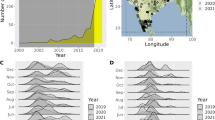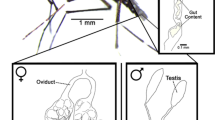Abstract
Here we provide the first evidence that Black Queen Cell Virus (BQCV), one of the most prevalent honey bee viruses, can cause an infection in bumble bees, Bombus huntii, and that the BQCV infection could spread to different tissues of bumble bees. The detection of negative strand RNA of BQCV, an indicator of active virus replication, in the gut of B. huntii suggests that virus particles replicate within the gut and then cross the gut lining to other tissues through hemolymph circulation. The observation of active replication of the BQCV in the gut, together with the fact that BQCV was more widespread in the body of field-collected bees than that of lab-reared bees, implies a possible association between the foraging activities of bumble bees and virus transmission. The fact that bumble bees and honey bees are able to share nectar and pollen resources in the same field suggests that geographical proximity of two host species could play a role in host range breadth of BQCV.



Similar content being viewed by others
References
Anderson, D.L. (1991) Kashmir bee virus—a relatively harmless virus of honey bee colonies. Am. Bee J. 131, 767–770
Anderson, D.L. (1993) Pathogens and queen bees. Australas. Beekeep. 94, 292–296
Bailey, L., Gibbs, A.J. (1964) Acute infection of bees with paralysis virus. J. Insect Pathol. 6, 395–407
Bailey, L., Woods, R.D. (1977) Two more small RNA viruses from honey bees and further observations on sacbrood and acute bee-paralysis viruses. J. Gen. Virol. 37, 175–182
Benjeddou, M., Leat, N., Allsopp, M., Davison, S. (2001) Detection of acute bee paralysis virus and black queen cell virus from honeybees by reverse transcriptase PCR. Appl. Environ. Microbiol. 67, 2384–2387
Boncristiani Jr., H.F., Di Prisco, G., Pettis, J.S., Hamilton, M., Chen, Y.P. (2009) Molecular approaches to the analysis of deformed wing virus replication and pathogenesis in the honey bee, Apis mellifera. Virol. J. 6, 221–230
Brown, M.J.F., Schmid-Hempel, R., Schmid-Hempel, P. (2003) Strong context-dependent virulence in a host-parasite system: reconciling genetic evidence with theory. J. Anim. Ecol. 72, 994–1002
Cameron, S.A., Lozier, J.D., Strange, J.P., Koch, J., Cordes, B.N., Solter, L.F., Griswold, T.L. (2011) Patterns of widespread decline in North American bumble bees. Proc. Nat. Acad Sci USA 108, 662–667
Chen, Y.P., Siede, R. (2007) Honey bee viruses. Adv. Virus Res. 70, 33–80
Chen, Y.P., Evans, J.D., Feldlaufer, M.F. (2006) Horizontal and vertical transmission of viruses in the honey bee, Apis mellifera. J. Invertebr. Pathol. 92, 152–159
Chenna, R., Sugawara, H., Koike, T., Lopez, R., Gibson, T.J., Higgins, D.G., Thompson, J.D. (2003) Multiple sequence alignment with the Clustal series of programs. Nucleic Acids Res 31, 3497–3500
Colla, S.R., Otterstatter, M.C., Gegear, R.J., Thomson, J.D. (2006) Plight of the bumble bee: Pathogen spillover from commercial to wild populations. Biol. Conserv. 129, 461–467
Davis, T.J., Pedersen, A.B. (2008) Phylogeny and geography predict pathogen community similarity in wild primates and humans. Proc. R. Soc. B 275, 1695–1701
Dohzond, I., Yokoyama, J. (2010) Impact of alien bees on native plant-pollinator relationships: a review with special emphasis on plant reproduction. Appl. Entomol. Zool. 45, 37–47
Evans, E., Spivak, M. (2006) Effects of honey bee (Hymenoptera: Apidae) and bumble bee (Hymenoptera: Apidae) presence on cranberry (Ericales: Ericaceae) pollination. J. Econ. Entomol. 99, 614–620
Genersch, E., Yue, C., Ingemar, F., de Mirandac, J.R. (2006) Detection of deformed wing virus, a honey bee viral pathogen, in bumble bees (Bombus terrestris and Bombus pascuorum) with wing deformities. J. Invertebr. Pathol. 91, 61–63
Heinrich, B. (2004) Bumblebee Economics, 2nd edn. Harvard University Press, Cambridge, Massachusetts
Hobbs, G.A. (1967) Ecology of species of Bombus (Hymenoptera: Apidae) in southern Alberta. VI. subgenus Pyrobombus. Can. Entomol. 99, 1271–1292
Leat, N., Ball, B., Govan, V., Davison, S. (2000) Analysis of the complete genome sequence of black queen-cell virus, a picorna-like virus of honey bees. J. Gen. Virol. 81, 2111–2119
Mayo, M.A. (2002) Virus taxonomy—Houston 2002. Arch. Virol. 147, 1071–1076
Niwa, S., Iwano, H., Asada, S., Matsuurra, M., Goka, K. (2004) A microsporidian pathogen isolated from a colony of the European bumblebee, Bombus terrestris, and infectivity on Japanese bumblebee. Jap. J. Appl. Entomol. Zool. 48, 60–64
Otterstatter, M.C., Thomson, J.D. (2008) Does pathogen spillover from commercially reared bumble bees threaten wild pollinators? PLoS One 3, e2771
Plischuk, S., Raquel, Martín-Hernández R., Prieto, L., Lucía, M., Botías, C., Meana, A., Abrahamovich, A.H., Lange, C., Higes, M. (2009) South American native bumblebees (Hymenoptera: Apidae) infected by Nosema ceranae (Microsporidia), an emerging pathogen of honeybees (Apis mellifera). Environ. Microbiol. Rep. 1, 131–135
Proctor, M., Yeo, P., Lack, A. (1996) In The natural history of pollination, pp. 387–388. Timber Press Inc, Portland, OR
Reader, T., MacLeod, I., Elliott, T.P., Robinson, O.J., Manica, A. (2005) Inter-order interactions between flower-visiting insects: foraging bees avoid flowers previously visited by hoverflies. J. Insect. Behav. 18, 51–57. doi:10.1007/s10905-005-9346-8
Schmid-Hempel, P. (2001) On the evolutionary ecology of host-parasite interactions—addressing the questions with bumblebees and their parasites. Naturwissenschaften 88, 147–158
Strange, J.P. (2011) Nest initiation in three North American bumble bees (Bombus): gyne number and presence of honey bee workers influence establishment success and colony size. J. Insect Sci. 10, 130. available online: insectscience.org/10.130
Velthuis, H.H.W., van Doorn, A. (2006) A century of advances in bumble bee domestication and the economic and environmental aspects of its commercialization for pollination. Apidologie 37, 421–451
Whitman, M. (2007) Humblebee Bumblebee. Wild Ones Journal, March/April issue
Yue, C., Genersch, E. (2005) RT-PCR analysis of deformed wing virus in honeybees (Apis mellifera) and mites (Varroa destructor). J. Gen. Virol. 86, 3419–3424
Acknowledgements
This work was funded by the Chinese “948” Ministry of Agriculture Project (no. 2006-G19(4), Chinese National Natural Science Foundation for Young Scholars (no. 30700606, no. 30972149), International joint research project (no. 2009DFA32600) and an USDA-CAP grant (2009-85118-05718).
Virus de la cellule noire de reine: extension de son spectre d’hôtes de l’abeille vers le bourdon Bombus huntii
spectre d’hôtes / bourdon / abeille / BQCV / transmission virale
Erweiterung des Wirtsspektrums des Black Queen Cell Virus auf die Hummel Bombus huntii
Wirtsspektrum / Hummel / Bombus huntii / Black queen cell virus
Author information
Authors and Affiliations
Corresponding author
Additional information
Manuscript editor: Peter Rosenkranz
Wenjun Peng and Jilian Li contributed equally in this work.
Rights and permissions
About this article
Cite this article
Peng, W., Li, J., Boncristiani, H. et al. Host range expansion of honey bee Black Queen Cell Virus in the bumble bee, Bombus huntii . Apidologie 42, 650–658 (2011). https://doi.org/10.1007/s13592-011-0061-5
Received:
Revised:
Accepted:
Published:
Issue Date:
DOI: https://doi.org/10.1007/s13592-011-0061-5




